
Soweto is a township of the City of Johannesburg Metropolitan Municipality in Gauteng, South Africa, bordering the city's mining belt in the south. Its name is an English syllabic abbreviation for South Western Townships. Formerly a separate municipality, it is now incorporated in the City of Johannesburg Metropolitan Municipality, and one of the suburbs of Johannesburg.

Winnie Madikizela-Mandela, also known as Winnie Mandela, was a South African anti-apartheid activist and politician, and the second wife of Nelson Mandela. She served as a Member of Parliament from 1994 to 2003, and from 2009 until her death, and was a deputy minister of arts and culture from 1994 to 1996. A member of the African National Congress (ANC) political party, she served on the ANC's National Executive Committee and headed its Women's League. Madikizela-Mandela was known to her supporters as the "Mother of the Nation".
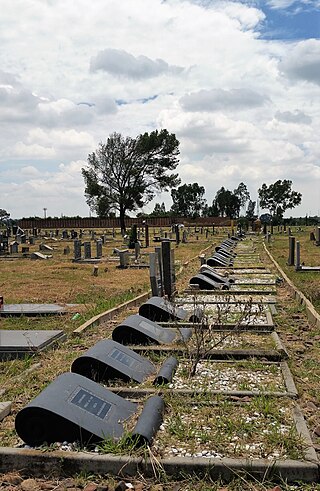
The Sharpeville massacre occurred on 21 March 1960 at the police station in the township of Sharpeville in the then Transvaal Province of the then Union of South Africa. After demonstrating against anti-black pass laws, a crowd of about 7,000 black protesters went to the police station. Sources disagree as to the behaviour of the crowd: some state that the crowd was peaceful, while others state that the crowd had been hurling stones at the police and that the mood had turned "ugly". The South African Police (SAP) opened fire on the crowd when the crowd started advancing toward the fence around the police station; tear-gas had proved ineffectual. There were 249 victims in total, including 29 children, with 69 people killed and 180 injured. Some were shot in the back as they fled.

Ciskei, officially the Republic of Ciskei, was a Bantustan for the Xhosa people, located in the southeast of South Africa. It covered an area of 7,700 square kilometres (3,000 sq mi), almost entirely surrounded by what was then the Cape Province, and possessed a small coastline along the shore of the Indian Ocean.
Sharpeville is a township situated between two large industrial cities, Vanderbijlpark and Vereeniging, in southern Gauteng, South Africa. Sharpeville is one of the oldest of six townships in the Vaal Triangle. It was named after John Lillie Sharpe who came to South Africa from Glasgow, Scotland, as secretary of Stewarts & Lloyds. Sharpe was elected to the Vereeniging City Council in 1932 and held the position of mayor from 1934 to 1937.
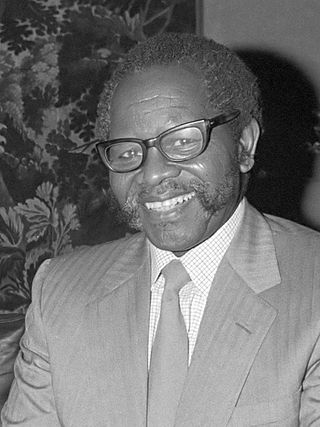
Oliver Reginald Kaizana Tambo was a South African anti-apartheid politician and activist who served as President of the African National Congress (ANC) from 1967 to 1991.
Sasolburg is the third largest city within the Metsimaholo Local Municipality in the far north of the Free State province of South Africa and is further sub-divided into three areas: Sasolburg proper, Vaalpark and Zamdela.
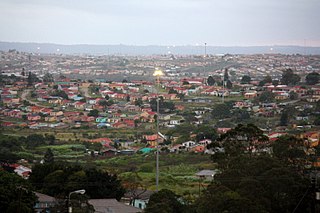
Mdantsane is a South African urban township situated 15 km away from East London and 37 km away from Qonce in the Eastern Cape. It is the second largest township in South Africa after Soweto in Gauteng.
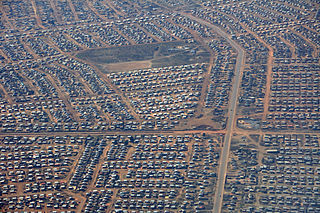
Thokoza, alternatively rendered Tokoza, is a township in Ekurhuleni, Gauteng. Thokoza is at the location of the now-defunct Palmietfontein Airport. It is situated south east of Alberton, adjacent to Katlehong. Thokoza was the first black township which was established in the South. During the early 1990s Thokoza was the middle of unrest between the supporters of the Inkatha Freedom Party (IFP) and the African National Congress (ANC).
Cato Manor is a settlement located 7 kilometres (4.3 mi) from the city centre of Durban, South Africa.

The apartheid system in South Africa was ended through a series of bilateral and multi-party negotiations between 1990 and 1993. The negotiations culminated in the passage of a new interim Constitution in 1993, a precursor to the Constitution of 1996; and in South Africa's first non-racial elections in 1994, won by the African National Congress (ANC) liberation movement.

The Bisho massacre occurred on 7 September 1992 in Bisho, in the then nominally independent homeland of Ciskei which is now part of the Eastern Cape in South Africa. Twenty-eight African National Congress supporters and one soldier were shot dead by the Ciskei Defence Force during a protest march when they attempted to enter Bisho to demand the reincorporation of Ciskei into South Africa during the final years of apartheid.
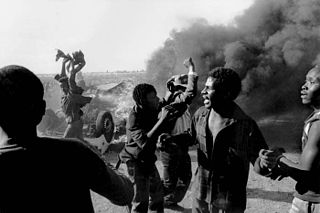
Operation Marion was a domestic military operation fielded by the South African Defence Force (SADF) during the 1980s. The apartheid security forces trained Inkatha operatives to build an irregular militia.
The Boipatong massacre took place on the night of 17 June 1992 in the township of Boipatong, South Africa.

Greg Marinovich is a Pulitzer-awarded South African photojournalist, filmmaker, photo editor, and member of the Bang-Bang Club.

Duncan Village is a township in the Buffalo City Metropolitan Municipality in the Eastern Cape province of South Africa. The township is located about five kilometres away from the East London central business district (CBD). Duncan Village is divided into six wards, with each headed by a ward councillor. There are no clear divisions between the informal and formal parts of the township since most shacks are planted on the open spaces within formal houses.
Siphiwe Mvuyane was a South African police officer who died on 9 May 1993. During the period of "low intensity warfare" in South Africa which largely pitted the African National Congress (ANC) and Inkatha Freedom Party (IFP), Siphiwe Mvuyane was on the side of the IFP. During the period of the "low intensity warfare", the IFP was the sole ruling party of the Bantustan KwaZulu government, and worked in collaboration with the apartheid government, whereas the ANC was operating underground; as a result the IFP had an upper hand over the ANC when it came to the warfare. But post apartheid, the African National Congress (ANC) became the governing party in South Africa whereas the Inkatha Freedom Party (IFP) became one of the opposition parties in the South African parliament, as a result the ANC gained the upper hand over the IFP in the remaining years of the warfare as the ANC was in control of the state apparatus by virtue of being the governing party. The IFP leadership denied its involvement in sanctioning and orchestrating political violence in the furtherance of its political objectives during the period of the "low intensity warfare" in South Africa.
Chris Hani, General-Secretary of the South African Communist Party (SACP), was assassinated by right-wing extremist Janusz Waluś on 10 April 1993. The assassination, later tied to members within the Conservative Party, occurred outside Hani's home in Dawn Park during a peak period of progressive anti-apartheid momentum in South Africa. After the assassination, racially fuelled riots drew international attention to the instability of the political division within South Africa, leading to an inclusive national democratic election in April 1994, won by the African National Congress (ANC). Waluś and his accomplice Clive Derby-Lewis were sentenced to death after their arrest in 1993; the sentence was later commuted to life imprisonment.

The Security Branch of the South African Police, established in 1947 as the Special Branch, was the security police apparatus of the apartheid state in South Africa. From the 1960s to the 1980s, it was one of the three main state entities responsible for intelligence gathering, the others being the Bureau for State Security and the Military Intelligence division of the South African Defence Force. In 1987, at its peak, the Security Branch accounted for only thirteen percent of police personnel, but it wielded great influence as the "elite" service of the police.
Thembinkosi Samson Khoza was a South African politician who represented the Inkatha Freedom Party (IFP) in the National Assembly from 1994 until his death in May 2000. He was a former leader of the IFP's Youth Brigade and served as the party's leader in Gauteng province. In the 1980s and 1990s, he was credited with expanding the IFP's political presence in the Transvaal.















